Experiments
The mood board helped me discover opposites such as the uncanny feeing vs. harmonization of living spaces as well as the feeling of being uncomfortable. It also showed me to question reality, or in other words, the everyday perception of things. I was therefore interested in creating something abnormal, to orchestrate a kind of urban sickness, where liquid would pour out of glands. These would be postulate some deeper malfunction or allergy -an architectural herpes. In this way, I could project some emotional feedback between the building/wall and the observer.
It is therefore important that the tools I use for movement and interaction be embedded in the surroundings. This means not using any mainstream technologies such as video projections, motors etc.
Several human input states have been defined:
- proximity (is it a single person, crowds, amount of people...)
- touch (pull, push, swing...)
- loundess (from different points)
In this first stage, I have started with some preliminary experiments in order to familiarize myself with the electro-active polymers (EAP) as this will be a main part of my project. In This first video, I have tested several possible usages involving EAP.

This is mostly non-interactive. In the next video, I have placed a piezo element to detect the change of pressure. This turns an embedded led on/off.

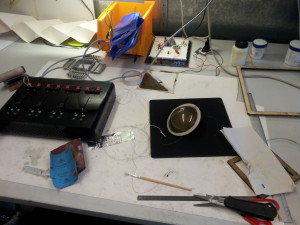
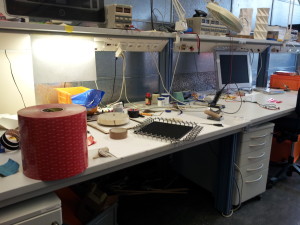
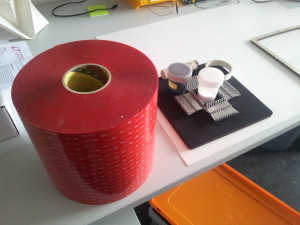
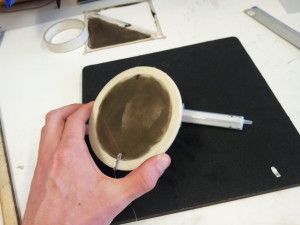
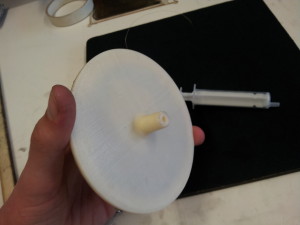
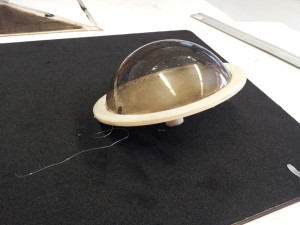
The EAP are built and assembled in the lab. I stretch the polymer to a certain amount, then place a frame on it, powder some graphite on both sides and attach cables on either side. After creating some basic frames, I undertook a form-finding experiment and how to make the polymer -which is very fragile- as strong as possible. I was primary interested in creating air-pressured modules with different kinds of forms.
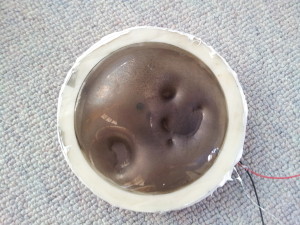
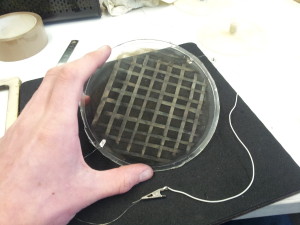
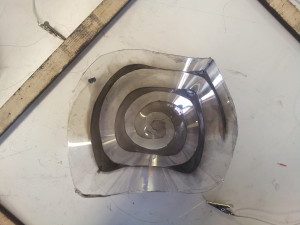
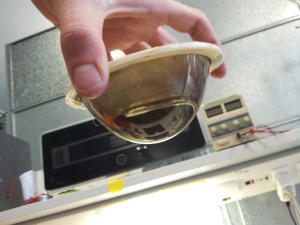
Using basic forms but inducing irregularities, one discovers new ideas and approaches.
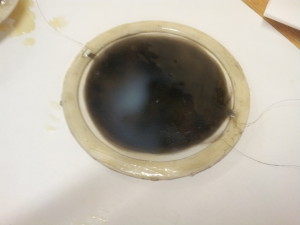
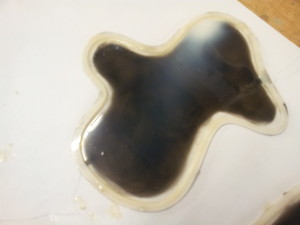
By adding latex to electrically isolate and strengthen the polymer, I am hoping to use them also as pressure sensitive devices at the same time.
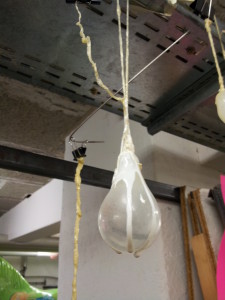
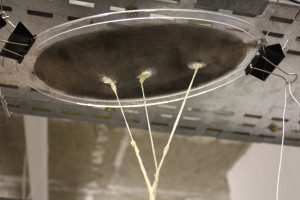
These are the very first prototypey of the hanging modules, which already have a strong resemblance as the prototype. The extensive use of latex milk helped to form the modules to an organic-threatening form.
Experimenting with LED light on top of the membrane with water acting as a deflector did not yield promising results. Instead, a sanded LED was pressed into the bloated finger stalls. Ultraviolet LED with Luminova powder added to latex milk gave mixed results. Luminova is very expensive and as the installation will roughly during daytime, UV modules were dropped.
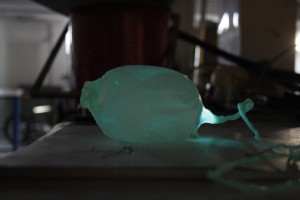
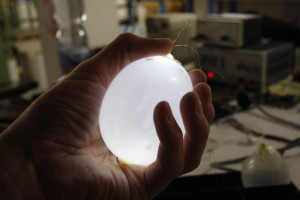
Creasing techniques to envelope the finger stalls in latex added veins to the else-wise flat surface. Broken finger stalls added a nice touch to liveliness of the blisters.
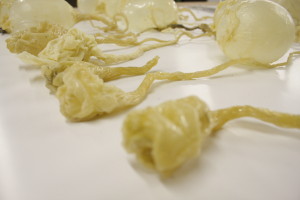
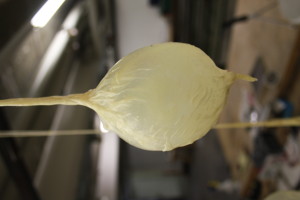
 This is mostly non-interactive. In the next video, I have placed a piezo element to detect the change of pressure. This turns an embedded led on/off.
This is mostly non-interactive. In the next video, I have placed a piezo element to detect the change of pressure. This turns an embedded led on/off.






 The EAP are built and assembled in the lab. I stretch the polymer to a certain amount, then place a frame on it, powder some graphite on both sides and attach cables on either side. After creating some basic frames, I undertook a form-finding experiment and how to make the polymer -which is very fragile- as strong as possible. I was primary interested in creating air-pressured modules with different kinds of forms.
The EAP are built and assembled in the lab. I stretch the polymer to a certain amount, then place a frame on it, powder some graphite on both sides and attach cables on either side. After creating some basic frames, I undertook a form-finding experiment and how to make the polymer -which is very fragile- as strong as possible. I was primary interested in creating air-pressured modules with different kinds of forms.



 Using basic forms but inducing irregularities, one discovers new ideas and approaches.
Using basic forms but inducing irregularities, one discovers new ideas and approaches.

 By adding latex to electrically isolate and strengthen the polymer, I am hoping to use them also as pressure sensitive devices at the same time.
By adding latex to electrically isolate and strengthen the polymer, I am hoping to use them also as pressure sensitive devices at the same time.

 These are the very first prototypey of the hanging modules, which already have a strong resemblance as the prototype. The extensive use of latex milk helped to form the modules to an organic-threatening form.
Experimenting with LED light on top of the membrane with water acting as a deflector did not yield promising results. Instead, a sanded LED was pressed into the bloated finger stalls. Ultraviolet LED with Luminova powder added to latex milk gave mixed results. Luminova is very expensive and as the installation will roughly during daytime, UV modules were dropped.
These are the very first prototypey of the hanging modules, which already have a strong resemblance as the prototype. The extensive use of latex milk helped to form the modules to an organic-threatening form.
Experimenting with LED light on top of the membrane with water acting as a deflector did not yield promising results. Instead, a sanded LED was pressed into the bloated finger stalls. Ultraviolet LED with Luminova powder added to latex milk gave mixed results. Luminova is very expensive and as the installation will roughly during daytime, UV modules were dropped.

 Creasing techniques to envelope the finger stalls in latex added veins to the else-wise flat surface. Broken finger stalls added a nice touch to liveliness of the blisters.
Creasing techniques to envelope the finger stalls in latex added veins to the else-wise flat surface. Broken finger stalls added a nice touch to liveliness of the blisters.

